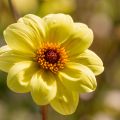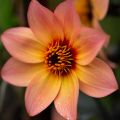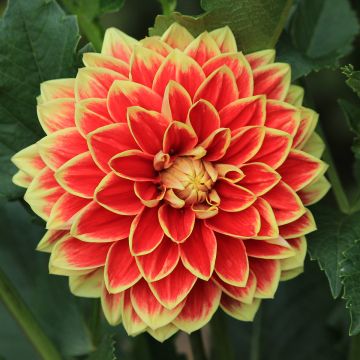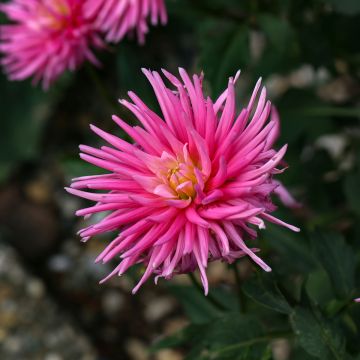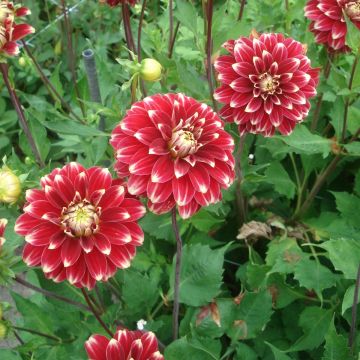

Happy Single Dahlias Collection
Happy Single Dahlias Collection
Dahlia Happy Single
I have had a happy single Princess for 3 years. It is a well-branched plant with a superb dark foliage that is very interesting. Not overly floriferous and the flowering takes a bit of time. Nevertheless, I really like this dahlia and it stands out in the garden.
danie, 26/02/2018
This item cannot be shipped to the selected country
Delivery charge from €5.90
More information
Schedule delivery date,
and select date in basket
This plant carries a 6 months recovery warranty
More information
We guarantee the quality of our plants for a full growing cycle, and will replace at our expense any plant that fails to recover under normal climatic and planting conditions.
From €5.90 for pickup delivery and €6.90 for home delivery
Express home delivery from €8.90.

Does this plant fit my garden?
Set up your Plantfit profile →
Collection items (12 plants)
Description
Collection of four varieties of dwarf dahlias belonging to the Happy Single series. These are adorable landscape dahlias, of low height (60 cm (24in)), characterised by very dark foliage and 7-8 cm (3in) flowers composed of a simple corolla surrounding a beautiful golden yellow centre. This flowering, which lasts from July until the first frost, is visited by butterflies and pollinating insects. They are delightful in borders, flowerbeds, or pots. The flowers last a long time in a vase.
This collection consists of:
3 x Dahlia Happy Single 'Party': canary yellow corolla, bright orange-yellow centre, cut foliage in brown colour.
3 x Dahlia Happy Single 'Juliet': candy pink corolla, almost black foliage.
3 x Dahlia Happy Single 'Princess': white petals sometimes slightly tinged with pale pink, foliage of a very dark purplish green.
3 x Dahlia Happy Single 'Kiss': salmon-coloured corolla petals tinged with brighter orange at the base, around a brown centre turning yellow. Bronze-green foliage with purplish reflections.
Dahlias are tuberous plants belonging to the Asteraceae family, originally from the high plateaus of Mexico. 'Happy Single' is a Dahlia with very dark foliage, whose flowers are organised in single heads, with outer ligules of variable colour, petal-shaped, surrounding a brown centre composed of tiny flowers adorned with yellow to orange stamens. The plant has a bushy and compact habit. The very branched stems are hollow and the opposite leaves are divided into 3 or 5 toothed lobes. The leaves and stems have a very original colour: bronze, purple, violet, Bordeaux, chocolate, almost black, they truly enhance the colour of the heads. The Happy Single dahlia usually does not require staking.
To promote reblooming be sure to cut off faded flowers - or even better, regularly make up large colourful bouquets. Happy Single dahlias pair particularly well with each other, as well as with the gray foliage of seaside cineraria and wormwoods (Powis Castle Wormwood, Lambrook Silver Artemisia absinthium). In flowerbeds, they can for example accompany Echinaceas that bloom at the same time, as well as light blue or mauve asters. Of course, their flowers are magnificent in bouquets.
Report an error about the product description
Plant habit
Flowering
Foliage
Botanical data
Dahlia
Happy Single
Asteraceae
Cultivar or hybrid
Other Dahlias
Planting and care
The Dahlia is easy to grow in all regions. For abundant flowering, it is good to follow a few simple rules. Plant the tubers in a sunny location as soon as the last frost has passed. Rich, fresh, well-drained soils are perfect. Waterlogged soil would promote tuber rot. Do not hesitate to amend the soil with compost and sand if necessary. Work the soil deeply and enrich it, for example, with powdered horn or dried blood. Place your tuber in the hole and crumble the soil well to fill in without leaving air pockets. Your dahlia should be covered with about 6 cm (2in) of soil. Water abundantly after planting, and then regularly during the first 6 weeks to aid rooting.
Dahlias are sensitive to cold, so they usually need to be overwintered. In November, the first frosts cause the foliage to blacken: this is the moment to dig them up. Carefully take up the tubers. Remove as much soil as possible. Let the foliage dry so that the tubers can replenish their reserves. Once dry cut the stems to 10 cm (4in). Spread your bulbs in a crate lined with newspaper. Store them frost-free in a dry, cool, and dark place, such as a frost-free garage or an attic. In warm regions close to the coast that experience only a few days of frost per year, and only moderate frosts (-5 to -10 °C), it is possible to leave them in place. In this case, simply cover the soil with a carpet of leaves or straw for protection.
Planting period
Intended location
Care
-
, onOrder confirmed
Reply from on Promesse de fleurs
Haven't found what you were looking for?
Hardiness is the lowest winter temperature a plant can endure without suffering serious damage or even dying. However, hardiness is affected by location (a sheltered area, such as a patio), protection (winter cover) and soil type (hardiness is improved by well-drained soil).

Photo Sharing Terms & Conditions
In order to encourage gardeners to interact and share their experiences, Promesse de fleurs offers various media enabling content to be uploaded onto its Site - in particular via the ‘Photo sharing’ module.
The User agrees to refrain from:
- Posting any content that is illegal, prejudicial, insulting, racist, inciteful to hatred, revisionist, contrary to public decency, that infringes on privacy or on the privacy rights of third parties, in particular the publicity rights of persons and goods, intellectual property rights, or the right to privacy.
- Submitting content on behalf of a third party;
- Impersonate the identity of a third party and/or publish any personal information about a third party;
In general, the User undertakes to refrain from any unethical behaviour.
All Content (in particular text, comments, files, images, photos, videos, creative works, etc.), which may be subject to property or intellectual property rights, image or other private rights, shall remain the property of the User, subject to the limited rights granted by the terms of the licence granted by Promesse de fleurs as stated below. Users are at liberty to publish or not to publish such Content on the Site, notably via the ‘Photo Sharing’ facility, and accept that this Content shall be made public and freely accessible, notably on the Internet.
Users further acknowledge, undertake to have ,and guarantee that they hold all necessary rights and permissions to publish such material on the Site, in particular with regard to the legislation in force pertaining to any privacy, property, intellectual property, image, or contractual rights, or rights of any other nature. By publishing such Content on the Site, Users acknowledge accepting full liability as publishers of the Content within the meaning of the law, and grant Promesse de fleurs, free of charge, an inclusive, worldwide licence for the said Content for the entire duration of its publication, including all reproduction, representation, up/downloading, displaying, performing, transmission, and storage rights.
Users also grant permission for their name to be linked to the Content and accept that this link may not always be made available.
By engaging in posting material, Users consent to their Content becoming automatically accessible on the Internet, in particular on other sites and/or blogs and/or web pages of the Promesse de fleurs site, including in particular social pages and the Promesse de fleurs catalogue.
Users may secure the removal of entrusted content free of charge by issuing a simple request via our contact form.
The flowering period indicated on our website applies to countries and regions located in USDA zone 8 (France, the United Kingdom, Ireland, the Netherlands, etc.)
It will vary according to where you live:
- In zones 9 to 10 (Italy, Spain, Greece, etc.), flowering will occur about 2 to 4 weeks earlier.
- In zones 6 to 7 (Germany, Poland, Slovenia, and lower mountainous regions), flowering will be delayed by 2 to 3 weeks.
- In zone 5 (Central Europe, Scandinavia), blooming will be delayed by 3 to 5 weeks.
In temperate climates, pruning of spring-flowering shrubs (forsythia, spireas, etc.) should be done just after flowering.
Pruning of summer-flowering shrubs (Indian Lilac, Perovskia, etc.) can be done in winter or spring.
In cold regions as well as with frost-sensitive plants, avoid pruning too early when severe frosts may still occur.
The planting period indicated on our website applies to countries and regions located in USDA zone 8 (France, United Kingdom, Ireland, Netherlands).
It will vary according to where you live:
- In Mediterranean zones (Marseille, Madrid, Milan, etc.), autumn and winter are the best planting periods.
- In continental zones (Strasbourg, Munich, Vienna, etc.), delay planting by 2 to 3 weeks in spring and bring it forward by 2 to 4 weeks in autumn.
- In mountainous regions (the Alps, Pyrenees, Carpathians, etc.), it is best to plant in late spring (May-June) or late summer (August-September).
The harvesting period indicated on our website applies to countries and regions in USDA zone 8 (France, England, Ireland, the Netherlands).
In colder areas (Scandinavia, Poland, Austria...) fruit and vegetable harvests are likely to be delayed by 3-4 weeks.
In warmer areas (Italy, Spain, Greece, etc.), harvesting will probably take place earlier, depending on weather conditions.
The sowing periods indicated on our website apply to countries and regions within USDA Zone 8 (France, UK, Ireland, Netherlands).
In colder areas (Scandinavia, Poland, Austria...), delay any outdoor sowing by 3-4 weeks, or sow under glass.
In warmer climes (Italy, Spain, Greece, etc.), bring outdoor sowing forward by a few weeks.

































